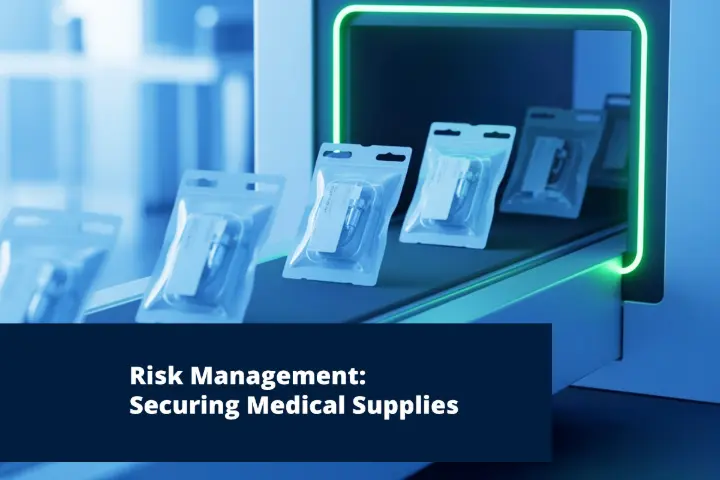
Procurement Risk Management: Avoiding Counterfeit and Substandard Medical Supplies
Counterfeit and substandard medical supplies aren’t just logistical headaches, they’re patient safety issues, brand reputation threats, and legal minefields. The United States has robust medical standards and systems in place to prevent substandard medical supplies from entering the healthcare industry, however, no system is perfect. According to The World Health Organization substandard and falsified medical products affect people all around the world with countries spending an estimated US$ 30.5 billion per year on substandard and falsified medical products.
It’s a risk procurement professionals need to be constantly aware of to prevent substandard medical supplies from landing at their medical facility. Proactive procurement risk management can help healthcare systems remain safe.
Supplier Vetting
Many RFIs and supplier scorecards can feel more box-ticking than meaningful evaluation, but when it comes to avoiding counterfeit medical supplies, surface-level diligence isn’t enough.
Start with comprehensive background checks. Look beyond pricing and delivery timelines and dig into a supplier’s financial stability, customer history, and most importantly, whether they’re licensed and authorized to distribute medical supplies in your country or region.
Researching and vetting suppliers can feel like additional time pressure, but it’s much easier to justify the time investment now than to explain a batch of compromised IV kits later on.
Once you’re sure a supplier meets all the necessary standards, a clear, legally binding supplier agreement helps set expectations and creates a paper trail in case something goes wrong. Include delivery standards and a section dedicated to quality assurance.
Verifying Product Authenticity
Even with a well-qualified supplier, product verification needs to be systematic and repeatable, not something left to gut feeling.
This is where serialization and track-and-trace technologies are invaluable. Implementing these systems helps trace every product back to its origin, which makes it exponentially harder for counterfeit items to sneak into the supply chain. If something does go wrong, you’ll have a breadcrumb trail to investigate.
Inspections should be frequent and multi-level. That doesn’t mean opening every package, but random batch checks, visual inspections for mismatched labeling, and validation against product specifications are good practices. It acts as your last line of defense before that product enters a care setting.
Adapting to Change
Another often overlooked part of medical procurement risk management is controlling what happens when things change. New suppliers, product updates, logistics reroutes - these changes may seem routine, but each one is a potential entry point for counterfeit or substandard products.
Implement a consistent change control procedure - every change should trigger a risk assessment: Will this impact product quality? Is the new vendor certified? Has the supply chain gone through proper vetting?
On the regulatory side, keep your systems and processes up-to-date to stay compliant. Laws and standards are evolving, especially as global distribution channels become more complex. Someone on the procurement team should be in charge of monitoring updates to medical supply standards and any changes in regulations or laws.
When Things Go Wrong
No one wants to talk about what happens after a counterfeit or substandard product slips through. If you suspect an issue, cooperate fully with investigations, whether it’s internal QA or an external regulatory body. Trying to bury a problem only compounds the damage.
Having clear documentation, signed supplier agreements, and traceability tools can help show good-faith effort and reduce liability. Transparency, even when uncomfortable, builds credibility with your internal teams and external partners alike.
Final Thought
There are no awards for preventing a problem that never became a headline, but this proactive work is what helps hospitals maintain quality standards and function safely. It’s what protects frontline clinicians and ultimately, patients. Medical procurement risk management isn’t just about avoiding counterfeit medical supplies, it’s about protecting trust in the whole system. Finding vetted suppliers with the right credentials and supply chain partnerships will go a long way toward keeping healthcare systems secure.
About MAP Medical
MAP Medical helps procurement teams find the supplies they need even when other distributors don’t have access to stock or can’t source hard to find items. With a product catalog featuring over 500,000 products from 3,000 manufacturers, MAP Medical supplies hospitals, acute care facilities, and educational & research labs with high quality products to match their exact requirements and budgets. Fast dispatch and delivery times, along with excellent customer service ensures the medical supply chain runs smoothly without interruption.
MAP Medical is more than just a supplier - we work as a strategic partner to enable every client that works with us to make tangible improvements in cost and time efficiencies. To find out more about how MAP Medical can help you, get in touch with our team today.


Procurement Risk Management: Avoiding Counterfeit and Substandard Medical Supplies